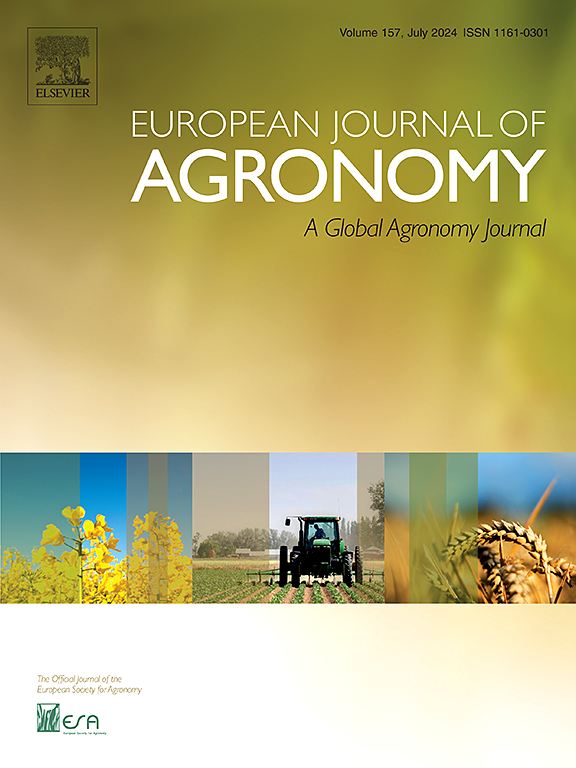基于改进SMOTE-CS小样本建模和深度特征学习的无人机多品种马铃薯晚疫病监测
IF 4.5
1区 农林科学
Q1 AGRONOMY
引用次数: 0
摘要
利用无人机(UAV)遥感数据对马铃薯晚疫病进行准确、无损监测,对田间管理具有重要意义。然而,在疾病暴发期间,缺乏普遍适用的快速监测模式。一方面,不同品种表现出不同程度的抗性和疾病监测进展,这可归因于遗传和环境因素。另一方面,区域间光谱和纹理数据的异质性、不平衡性和噪声给疾病监测带来了重大挑战。为了解决这些问题,本研究首先采用基于紧凑性和可分性特征选择(FS-CS)原则的增强特征选择算法,改进了合成少数派过采样技术(SMOTE)中的噪声问题。随后,将特征排序与重要排序加权平均(IOWA)算子一起计算诱导Minkowski OWA距离(IMOWAD),取代SMOTE中使用的最近邻距离。这种改进强调了合成样本区域的边界,并减轻了与噪声相关的问题。这种改进的方法被称为SMOTE-CS。其次,构建了9个模型,评估了多数据集集成时FS-CS在特征选择方面的有效性。与mRmR和ReliefF相比,FS-CS在特征数量较少的情况下获得了更高的精度。最后,为了解决品种和环境差异,分别使用浅迁移学习1D-CNN模型和结合非线性软阈值处理的深度DRSN模型进行建模。结果表明,1D-CNN模型在两个数据集上的总体精度(OA)分别为0.99和0.93。然而,其性能受到合成源和目标域样本边界可解释性差的影响。将非线性软阈值法融入到DRSN模型中,增强了DRSN模型的特征提取能力和噪声抑制能力。它在两个数据集上表现出很强的性能,OA为0.91,Kappa系数为0.86。与原来的SMOTE版本相比,该方法具有更好的泛化能力。本研究结果对小样本不平衡、噪声等问题提供了新的认识,并为不同地区多物种PLB监测提供了技术支持。本文章由计算机程序翻译,如有差异,请以英文原文为准。
Multi-variety monitoring of potato late blight severity using UAV data with improved SMOTE-CS for small sample modeling and deep feature learning
Accurate and non-destructive monitoring of potato late blight (PLB) using unmanned aerial vehicle (UAV) remote sensing data is of great significance for field management. However, during disease outbreaks, there is a lack of universally applicable rapid monitoring models. On the one hand, different varieties exhibit varying levels of resistance and disease monitoring progression, which can be attributed to genetic and environmental factors. On the other hand, the heterogeneity, imbalance, and noise in spectral and textural data across regions pose significant challenges for disease monitoring. To address these issues, this study first improves upon the noise problem in Synthetic Minority Over-sampling Technique (SMOTE) by employing an enhanced feature selection algorithm based on the Feature Selection with Compactness and Separability (FS-CS) principle. Subsequently, the feature ranking is then used with the Importance-Ordered Weighted Averaging (IOWA) operator to calculate the induced Minkowski OWA distance (IMOWAD), replacing the nearest neighbor distance used in SMOTE. This refinement emphasizes the boundaries of synthetic sample regions and mitigates noise-related issues. This improved method is referred to as SMOTE-CS. Secondly, nine models were constructed to evaluate the effectiveness of FS-CS in feature selection when integrating multiple datasets. Compared to mRmR and ReliefF, FS-CS achieved higher accuracy with a smaller number of features. Finally, to address varietal and environmental differences, modeling was conducted using a shallow transfer learning 1D-CNN model and a deep DRSN model incorporating nonlinear soft thresholding processing, respectively. The results indicate that the 1D-CNN model achieved overall accuracies (OA) of 0.99 and 0.93 on the two datasets, respectively. However, its performance was affected by the poor interpretability of the boundary between the synthetic source and target domain samples. The integration of nonlinear soft-thresholding into the DRSN model enhanced its feature extraction capability and noise suppression. It demonstrated strong performance on the two datasets, achieving an OA of 0.91 and a Kappa coefficient of 0.86. Compared to the original SMOTE version, the proposed approach exhibited superior generalization ability. The results of this study provide new insights into the problems of small sample imbalance, noise, and technical support for multi-species PLB monitoring in different regions.
求助全文
通过发布文献求助,成功后即可免费获取论文全文。
去求助
来源期刊

European Journal of Agronomy
农林科学-农艺学
CiteScore
8.30
自引率
7.70%
发文量
187
审稿时长
4.5 months
期刊介绍:
The European Journal of Agronomy, the official journal of the European Society for Agronomy, publishes original research papers reporting experimental and theoretical contributions to field-based agronomy and crop science. The journal will consider research at the field level for agricultural, horticultural and tree crops, that uses comprehensive and explanatory approaches. The EJA covers the following topics:
crop physiology
crop production and management including irrigation, fertilization and soil management
agroclimatology and modelling
plant-soil relationships
crop quality and post-harvest physiology
farming and cropping systems
agroecosystems and the environment
crop-weed interactions and management
organic farming
horticultural crops
papers from the European Society for Agronomy bi-annual meetings
In determining the suitability of submitted articles for publication, particular scrutiny is placed on the degree of novelty and significance of the research and the extent to which it adds to existing knowledge in agronomy.
 求助内容:
求助内容: 应助结果提醒方式:
应助结果提醒方式:


